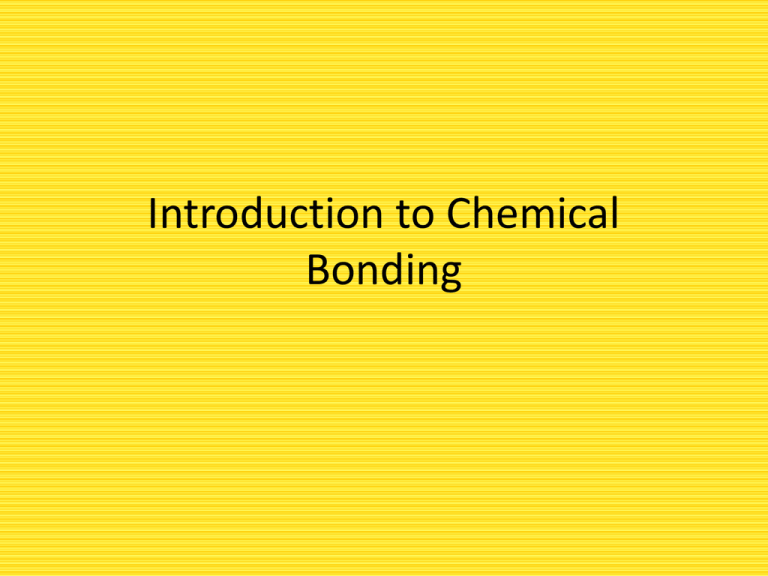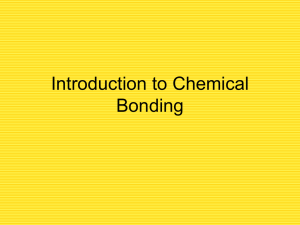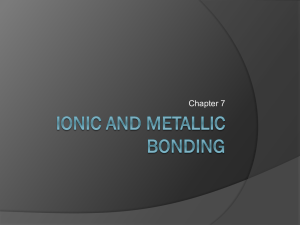Introduction to Chemical Bonding
advertisement

Introduction to Chemical Bonding Chemical Reactions: • During chemical reactions, elements combine, rearrange, or break apart with others to form new substances. • New substances are created when chemical bonds are broken or created. New Substance Original Substance Chemical Reaction Magnesium Metal http://www.polmag.pl/en/media/magnesium.jpg http://www.bcscience.com/images/m agnesium_burn.jpg Magnesium Oxide http://jchemed.chem.wisc.edu/JCESOFT/CCA/CC 3/STILLS/MAGAIR/MAGAIR/64JPG48/6.JPG Evidence of Chemical Reactions: Fire/Burning Color change without dye New gas created Heat released Heat absorbed ://en.wikipedia.org/wiki/Self-heating_can tp://static.howstuffworks.com/gif/coldpack.jpg • • • • • http://amazingrust.com/Experiments /background_knowledge/Images/Fir e-big.jpg http://z.about.com/d/chemistry/1 /G/5/a/demonstration.jpg http://www.uncp.edu/home/mcclurem/pta Compounds are more than one kind of element joined together. Octet Rule: Describes how chemical bonds happen. • Atoms want a full valence (or outer electron energy level). • Full valence will mean having 8 valence electrons. http://www.chemprofessor.com/periodicqm_files/image005.gif Why are these atoms negative? Octet Rule … Gaining electrons (and electrons •are Tonegative) reach full valence, means more some atoms “want” to It is easier for atom to lose electrons others “want” tothe gain negative charge thanand positive gain 1, 2 or 3 electrons rather charges (protons). electrons. than losing 5, 6 or 7. – Atoms with FEWER than 4 valence electrons will bond by losing those electrons. • These atoms will become positively charged! – Atoms with MORE thanIt4isvalence electrons easier for the atomwill to bond byatoms gaining electrons (up to3eight). lose 1, 2 or electrons rather Why are these positive? than gaining 5, 6 or 7. • These atoms will become negatively charged! Losing electrons (and electrons –are Atoms with means 4 valence electrons can gain or lose negative) electrons. It depends more protons (positive charge)on the element to which it is negative bonding.charges. than Example: Sodium (Na) • Valence? 1 • Easiest way to follow Octet Rule? Lose 1 electron • If following Octet Rule, what’s the charge? +1 http://www.historyforkids.org/scienceforkids/chemistry/atoms/ pictures/sodium.jpg A chemical bond is created by the sharing or exchange of electrons between elements. Example: Fluorine (F) • Valence? 7 • Easiest way to follow Octet Rule? Gain 1 electron • If following the Octet Rule, what’s the charge? –1 http://www.bbc.co.uk/schools/gcsebitesi ze/science/images/diag_fluorine.gif What will happen if Sodium and Fluorine atoms are mixed? • Electrons could transfer between the atoms. • A sodium atom could lose an electron to a fluorine atom. • Both atoms are left with full valence & are bonded together, creating a compound.








